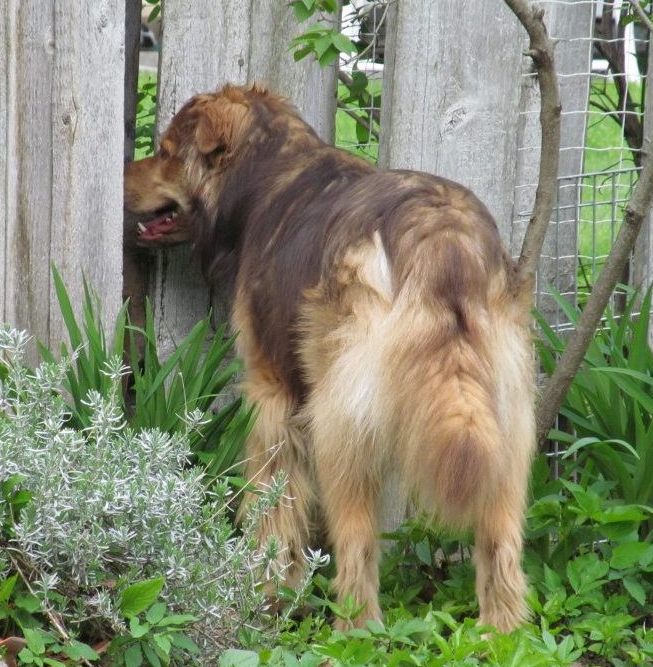It’s been two months now. I still can’t write about it easily. My dog was diagnosed with Canine Cognitive Dysfunction (CCD) in April of last year. He got much worse, way too quickly. He was exhausted. He was humanely euthanized in February.
Valentine’s Day is my favorite holiday. I got up early, with hope. He’d eaten a warm baked chicken breast, with enthusiasm, days before, and I hoped he would again. He did. He ate it all, eagerly, watching without walking away, his nose almost on it, while I pulled the last meat off the bones. It was enough that, even if he ate nothing else all day, it would be okay. Nutrition, healthy enough, was always available with a quick trip to the store. I was so glad.
My emotions connected to his eating were no longer complicated: if he ate, I was ecstatic; if he did not, I was dejected. Every day, every time, every morsel of any food—if I offered it, he might turn his head away, he might walk out of the room. It was rejection, but nothing personal, just “I am not going to eat that.” The next day, or an hour later, he would eat it, the exact same thing—he would not reject it.
I had struggled with his food issues from hours after his diagnosis. It was as if his ‘eager eater’ persona disappeared overnight. I never understood what was going on with him and food. Months later, I had to accept that whatever was happening on the current day was not going to be happening tomorrow. It would change; that was predictable. And no matter how it might seem in the moment, it was not going to change for the better.
That whole chicken breast on Valentine’s morning was the last he ever ate. Within days, he rejected cooked hamburger, deli meats, and his favorite—Happy Howie’s. I shopped online and at local stores for anything he would/might eat that would be good nutrition. More failures than successes, and the successes were, you guessed it, not lasting. He’d have a few bites of something some days, of something else on other days. His last meals consisted of several soft molasses cookies and halves of Danish horn pastries—for which he clearly indicated interest (the near nose poke) and which he ate with great enthusiasm.
When he was weighed before the euthanasia, he was the same weight he had been on the day he was diagnosed. He may have gained or lost weight during those nine months. I see the irony: he had not been starving in those last weeks, no matter how much I worried.
It was his loss of mobility that had scared me, too, and his speedy segue into so many of the symptoms he had not displayed until then, when he became so totally typical. He stood on the wrong side of doorways, he circled in corners, he stalled out on stair landings.
Outside, with winter weather, freezing fog, and slippery surfaces everywhere, his physical uncertainty became a more serious safety issue. On the long line, he tangled when he tried to get on the back steps from the wrong side. I had to get him turned around so I could guide and help support him to climb the steps, even with the stairs heavily sanded for traction.
The inside staircase was scary, too, when he forgot to keep moving up. His back feet slipped and he started sliding down toward me, since I was standing two steps below him. That happened twice, and both times I was lucky to stop him before both of us slid down. He could have broken something—or I could have. I set it up better after that and we stayed safe those last days. But no matter what I did, there was no guarantee. There was only hope.
You’ve heard people say their animals have “let them know” it was time to let them go. My dog was so stoic, I didn’t expect that of him. He surprised me again. One night, I’d helped him climb up on my bed, something he couldn’t manage on his own by then. It was his happy place, and it hurt to watch him give up after several tries to leap up with little effort, as he always had. I helped him up, helped him settle when he could not stop circling, praised him calmly when he found a comfy spot and curled up, relaxed, near me. He lifted his head, looked straight at me, breathed out; the dog version, I think, of a sigh. It was then that I understood—he was exhausted. “I know,” I told him. “You’ve been so brave.” It was time.
I made the arrangements and we went to our vet’s, where we were treated with consideration and kindness. My dog was euthanized. He is safe now. I like to think he is with all the other dogs and cats and ferrets who have lived with me. They are showing him around and sharing memories of our lives together. He’s not gone, nor are they—they’re in my heart.

Photo by Val Hughes
Here are all the chapters in our story that appeared in my weekly blog:
May 11, 2023 Canine Cognitive Dysfunction—Could It Affect Your Dog?
May 18, 2023 Canine Cognitive Dysfunction—Personal Stories and Suggestions
June 1, 2023 Canine Cognitive Dysfunction—Answers To Your Questions About My Dog
June 15, 2023 Canine Cognitive Dysfunction—My Dog Goes “Off His Feed”
June 29, 2023 Canine Cognitive Dysfunction—Is My Dog Better? No. He’s Different
July 13, 2023 Canine Cognitive Dysfunction—The Night Barker
July 27, 2023 Canine Cognitive Dysfunction—Symptomatic Behavior
August 10, 2023 Canine Cognitive Dysfunction—My Dog Still Makes Me Laugh
September 7, 2023 Canine Cognitive Dysfunction—More Surprises
November 9, 2023 Canine Cognitive Dysfunction—Changes For The Better
December 14, 2023 Canine Cognitive Dysfunction—Recalling The Recall
February 1, 2024 Canine Cognitive Dysfunction—Adjusting To The Arctic Blast



